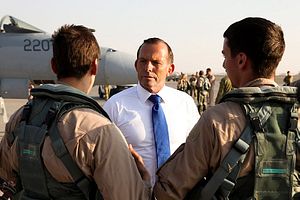On June 29, the leaders of Australia and Singapore inked a new comprehensive strategic partnership (CSP) at a ceremony during Australian Prime Minister Tony Abbott’s first visit to the city-state since taking office in 2013. The pact, signed during the 50th anniversary of the Australia-Singapore relationship, attests to the importance both sides attach to bilateral ties as well as the potential for them to strengthen further in various areas over the next few years.
Australia and Singapore already had a robust relationship even before the signing of the CSP. Australian soldiers gave their lives to defend Singapore during the Second World War, and Australia was the first country to establish relations with independent Singapore following its separation from Malaysia in 1965. But the CSP – which Singapore prime minister Lee Hsien Loong called a “transformational” agreement – elevates the bilateral relationship to a level that makes each a top partner of the other. For Singapore, the agreement is the first of this kind it has had with any other country. For Australia, the pact has been compared to a similar agreement Australia has with only neighboring New Zealand – the most open border arrangement it has with any other nation.
Substantively, as is often the case with other similar strategic partnerships, the CSP will see the two sides deepen cooperation across four fields: economics; foreign affairs; defense/security and people-to-people ties through a roadmap known as Project 2025. Australian and Singaporean officials have already been hard at work on the specifics of this, some of which were unveiled last year as part of the joint communique following the Eighth Singapore-Australia Joint Ministerial Committee. But Singapore’s Minister for Foreign Affairs and Law K Shanmugam and Australia’s Minister for Trade and Investment Andrew Robb have been charged with overseeing the implementation of the roadmap in the coming years across these areas.
In the economic realm, both sides already have built a robust relationship with a Singapore-Australia Free Trade Agreement (SAFTA) as its cornerstone. Singapore is Australia’s 5th largest overall trading partner and Canberra’s largest trading partner in ASEAN, while investment has also continued to increase. But they will look to update SAFTA to ensure its continued relevance in the coming years. Lee said that the focus would be on making the agreement more “business-friendly,” increasing the mobility of professionals, as well as facilitating opportunities for Singaporean businesses to establish a foothold in resource-rich Northern Australia. Abbott has been promoting the government’s recently announced White Paper on Developing Northern Australia, and he hosted a high-level investment roundtable with top Singaporean firms on available commercial opportunities.
On defense and security, both sides will build on the strong foundation they already have. Singapore and Australia are part of the Five Power Defense Arrangements, Singaporean troops already train in Australia and both sides have robust cooperation in various areas including intelligence-sharing. But the two sides plan on finalizing a new memorandum of understanding (MoU) covering defense by July next year. Singapore could receive greater access to military training areas and participate in joint development of training facilities in Australia. The CSP would also pave the way for greater collaboration in fighting terrorism, organized crime and cybercrime. Among these, terrorism and the Islamic State has been a top concern for both countries (See: “Singapore Warns of Islamic State Base in Southeast Asia”). It was thus no surprise that Lee and Abbott made headway on counterterrorism this week, including signing an MoU and paying a visit to the Religious Rehabilitation Group at Khadijah Mosque – one of the achievements of Singapore’s deradicalization program. (See: “Singapore Convenes New Counterterrorism Symposium”).
On foreign affairs, the two countries will look to enhance their collaboration on regional and international issues under the CSP. There is much room for greater cooperation in this respect. Australia has been a longtime dialogue member of ASEAN and is also a member of the East Asia Summit. Beyond common affiliations, both share what Singapore’s high commissioner to Australia Burhan Gafoor recently called “a common strategic outlook,” including a commitment to a rules-based international order as illustrated by their involvement in the Trans-Pacific Partnership and calls for respect for international law in the South China Sea. There are also opportunities for Singapore and Australia to further strengthen their joint support for less developed countries in the region, including via new third country training programs.
Last but not least, under the CSP will both sides hope to work towards strengthening people-to-people ties. The two-way figures for exchanges – be it for tourists, students, businessmen or academics – are already quite impressive, and recent measures like the New Colombo Plan will boost them even further. In the coming years, the two governments will look to make even greater improvements on this score, including by increasing student internship opportunities and strengthening cooperation between arts institutions. As a symbol of the importance of this dimension of the relationship on the 50th anniversary of ties, the Australian High Commission organized fifty barbecues involving 10,000 steaks held simultaneously across Singapore, with Abbott and Lee both stopping by one at Bishan-Ang Mo Kio Park.
In his remarks delivered at the 35th Singapore Lecture near the end of his two-day visit, Abbott said that with the CSP set to produce a whole level of intimacy over the next decade, Singapore and Australia were becoming not just friends, but family. If this goal is realized, it would be of great value not only to both countries, but the region and the world at large as well.

































